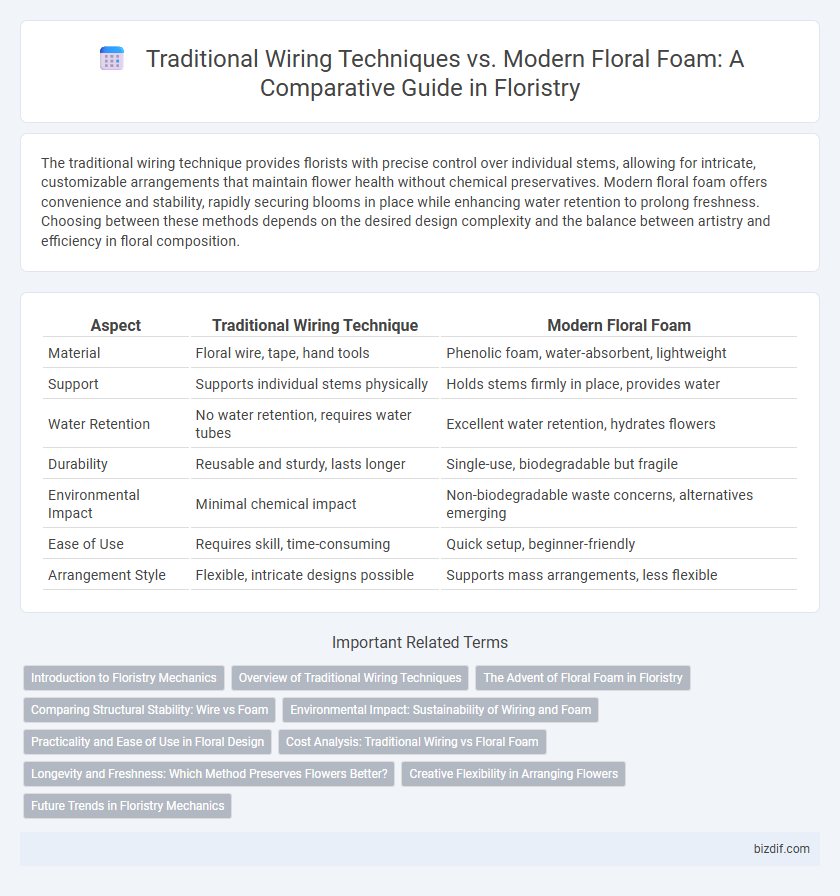The traditional wiring technique provides florists with precise control over individual stems, allowing for intricate, customizable arrangements that maintain flower health without chemical preservatives. Modern floral foam offers convenience and stability, rapidly securing blooms in place while enhancing water retention to prolong freshness. Choosing between these methods depends on the desired design complexity and the balance between artistry and efficiency in floral composition.
Table of Comparison
| Aspect | Traditional Wiring Technique | Modern Floral Foam |
|---|---|---|
| Material | Floral wire, tape, hand tools | Phenolic foam, water-absorbent, lightweight |
| Support | Supports individual stems physically | Holds stems firmly in place, provides water |
| Water Retention | No water retention, requires water tubes | Excellent water retention, hydrates flowers |
| Durability | Reusable and sturdy, lasts longer | Single-use, biodegradable but fragile |
| Environmental Impact | Minimal chemical impact | Non-biodegradable waste concerns, alternatives emerging |
| Ease of Use | Requires skill, time-consuming | Quick setup, beginner-friendly |
| Arrangement Style | Flexible, intricate designs possible | Supports mass arrangements, less flexible |
Introduction to Floristry Mechanics
Traditional wiring techniques in floristry provide structural support by wrapping stems with floral wire to create stable frameworks, essential for intricate designs and maintaining flower longevity. Modern floral foam offers convenience by securely anchoring stems in pre-shaped blocks that retain water, enhancing hydration and simplifying arrangement construction. Understanding both methods is crucial for florists aiming to balance durability and freshness in floral mechanics.
Overview of Traditional Wiring Techniques
Traditional wiring techniques in floristry involve manually wrapping floral stems with thin metal wires to provide structure and support, allowing intricate designs and shapes in arrangements. This method offers greater flexibility for artisan bouquets, corsages, and boutonnieres, preserving natural stem movement and airflow critical for flower longevity. While labor-intensive, traditional wiring enhances durability and precision, maintaining the botanical integrity absent in modern floral foam usage.
The Advent of Floral Foam in Floristry
The advent of floral foam revolutionized floristry by providing a lightweight, water-retentive medium that supports stems securely and extends flower freshness compared to traditional wiring techniques. Traditional wiring involves manually securing stems with wires, which can be time-consuming and less stable for intricate arrangements. Floral foam enhances design flexibility and efficiency, allowing florists to create more complex structures with improved hydration and longevity for floral displays.
Comparing Structural Stability: Wire vs Foam
Traditional wiring offers superior structural stability for intricate floral designs by securely binding stems, allowing precise shaping and long-lasting support in arrangements. Modern floral foam provides instant stability by immobilizing stems within a water-retentive matrix, ideal for quick assembly but prone to decomposition and environmental concerns over time. Wire ensures durable, flexible frameworks essential for complex, wearable, or sculptural floristry, whereas floral foam excels in convenience and hydration but compromises long-term arrangement integrity.
Environmental Impact: Sustainability of Wiring and Foam
Traditional wiring techniques in floristry rely on metal wires that are reusable and recyclable, significantly reducing waste compared to single-use floral foam. Modern floral foam, typically made from non-biodegradable plastics, poses environmental hazards due to its slow decomposition and contribution to landfill pollution. Sustainable alternatives include biodegradable floral foam and the increased use of wiring, promoting eco-friendly practices within the floral industry.
Practicality and Ease of Use in Floral Design
Traditional wiring technique offers precise control and durability in floral arrangements, allowing designers to manipulate stems for intricate designs while maintaining natural flower integrity. Modern floral foam provides unmatched convenience by securely holding stems in place and supplying water, significantly reducing assembly time and effort. Floral foam, however, generates waste and may limit creativity compared to the versatile applications of wiring methods in complex floral structures.
Cost Analysis: Traditional Wiring vs Floral Foam
Traditional wiring in floristry typically incurs lower material costs due to reusable wire and minimal waste, making it cost-effective for small-scale or custom arrangements. Floral foam, while more expensive per unit and single-use by design, significantly reduces labor time and supports complex, large-scale installations, potentially lowering overall labor costs. Evaluating cost efficiency depends on project scope, with floral foam favored for volume and speed, whereas wiring excels in sustainability and precision.
Longevity and Freshness: Which Method Preserves Flowers Better?
Traditional wiring techniques offer superior longevity by providing natural air circulation and minimizing flower stem damage, resulting in extended freshness. Modern floral foam retains moisture efficiently, promoting immediate hydration but often accelerates stem decomposition due to restricted airflow. For preserving flowers over time, wired arrangements generally maintain freshness longer compared to floral foam, which suits short-term displays.
Creative Flexibility in Arranging Flowers
Traditional wiring techniques in floristry offer unparalleled creative flexibility, allowing florists to shape and position individual stems with precision for intricate designs. Modern floral foam provides a stable base for arranging flowers quickly but limits the freedom to manipulate stems extensively. By combining traditional wiring with floral foam, florists can maximize both structural support and artistic expression in their arrangements.
Future Trends in Floristry Mechanics
Traditional wiring techniques in floristry provide structural support and flexibility for intricate designs, while modern floral foam offers convenience and water retention but raises environmental concerns. Future trends in floristry mechanics emphasize sustainable alternatives to floral foam, such as biodegradable materials and reusable structures that combine the strengths of both methods. Innovations in eco-friendly wiring and foam substitutes are expected to shape floral design practices by balancing durability, aesthetics, and environmental impact.
Traditional wiring technique vs modern floral foam Infographic

 bizdif.com
bizdif.com